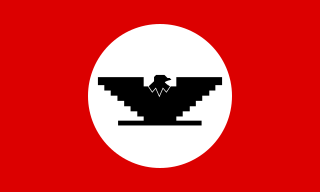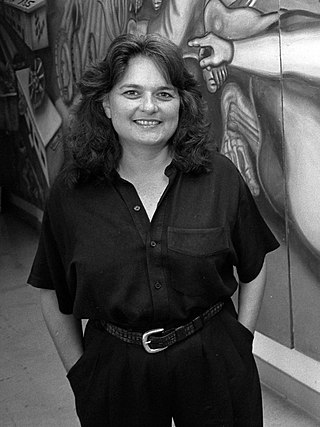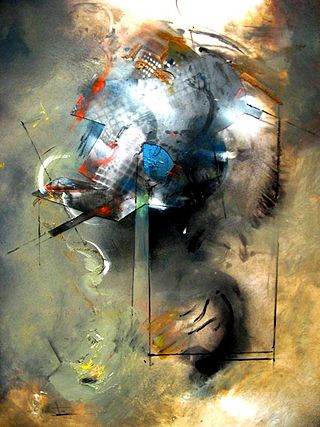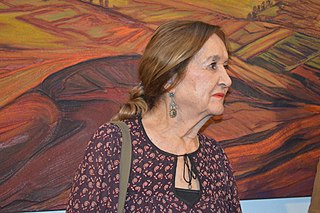
The Eastside is an urban region in Los Angeles County, California. It includes the Los Angeles City neighborhoods east of the Los Angeles River—that is, Boyle Heights, El Sereno, and Lincoln Heights—as well as unincorporated East Los Angeles.

City Terrace is an unincorporated area of East Los Angeles, in Los Angeles County, California, east of Downtown Los Angeles. It contains City Terrace Elementary School, Robert F. Kennedy Elementary School, Esteban Torres High School, Harrison Elementary School, William R. Anton Elementary School, Hammel Street Elementary School, Anthony Quinn Library, City Terrace Library, and City Terrace Park. It is part of the Census-designated place of East Los Angeles.

The Royal Chicano Air Force (RCAF) is a Sacramento, California-based art collective, founded in 1970 by Ricardo Favela, José Montoya and Esteban Villa. It was one of the "most important collective artist groups" in the Chicano art movement in California during the 1970s and the 1980s and continues to be influential into the 21st century.

The Centro Cultural de la Raza is a non-profit organization with the specific mission to create, preserve, promote and educate about Chicano, Mexicano, Native American and Latino art and culture. It is located in Balboa Park in San Diego, California. The cultural center supports and encourages the creative expression “of the indigenous cultures of the Americas.” It is currently a member of the American Alliance of Museums.

Carlos Mérida was a Guatemalan artist and naturalized Mexican who was one of the first to fuse European modern painting to Latin American themes, especially those related to Guatemala and Mexico. He was part of the Mexican muralism movement in subject matter but less so in style, favoring a non-figurative and later geometric style rather than a figurative, narrative style. Mérida is best known for canvas and mural work, the latter including elements such as glass and ceramic mosaic on major constructions in the 1950s and 1960s. One of his major works 4000m2 on the Benito Juarez housing complex, was completely destroyed with the 1985 Mexico City earthquake, but a monument to it exists at another complex in the south of the city.

José Raúl Anguiano Valadez was a notable Mexican painter of the 20th century, part of the “second generation” of Mexican muralists which continued the tradition of Diego Rivera, José Clemente Orozco and David Alfaro Siqueiros but experimented with it as well. Anguiano was born during the height of the Mexican Revolution, which would inspire a majority of his mural painting. He studied painting in his hometown of Guadalajara before moving to Mexico City to begin his career. His first major exhibition was held at the Palacio de Bellas Artes, at age 20. His works include over 100 individual and collective exhibitions with 50 murals, mostly in Mexico and the United States. As he continued his artistry with aspects of the Mexican muralism movement, he also experimented with other styles such as Cubism, Surrealism and Expressionism, with themes such as clowns and prostitutes. However, his most famous painting is “La espina” which depicts a Mayan woman digging a thorn out of her foot with a knife. His later works concentrated on depicting Mexico in vivid colors and traditional imagery.

Judith Francisca Baca is an American artist, activist, and professor of Chicano studies, world arts, and cultures based at the University of California, Los Angeles. She is the co-founder and artistic director of the Social and Public Art Resource Center (SPARC) in Venice, California. Baca is the director of the mural project that created the Great Wall of Los Angeles, which was the largest known communal mural project in the world as of 2018.

The Roman Catholic Archdiocese of Tuxtla is a Metropolitan Archdiocese based in Tuxtla, Chiapas, Mexico. It is responsible for the suffragan dioceses of Tapachula and Las Casas. Pope Benedict XVI elevated it to the level of archdiocese on 25 November 2006.

East Los Streetscapers Public Art Studios is a muralist art collective and fine art studio based in East Los Angeles, California. Its members have executed over twenty murals and large-scale public artworks, primarily in the Los Angeles area.

Jorge González Camarena was a Mexican painter, muralist and sculptor. He is best known for his mural work, as part of the Mexican muralism movement, although his work is distinct from the main names associated with it. His major works include the mural on the main administration building of the Monterrey Institute of Technology and Higher Studies and a mural created for the Universidad de Concepción in Chile. He also created easel works, one of which, La Patria, was well known in Mexico as it was used on the cover of free textbooks from the 1960s into the 1970s. Recognitions for his work include the Premio Nacional de Arte, membership in the Academia de Artes and the Ordine al Merito della Repubblica Italiana, grade Commendatore from the Italian government.
Narciso Botello was a chief of staff for Mexican General Joaquín Ramírez y Sesma before the Mexican–American War and was the first Southern California member of the California State Assembly after California organized its legislature.

Generación de la Ruptura is the name given by art critic Teresa del Conde to the generation of Mexican artists against the established Mexican School of Painting, more commonly called Mexican muralism post World War II. It began with the criticisms of José Luis Cuevas in the early 1950s, followed by others who thought the established art had become dogmatic, formulaic and nationalistic and the artists too deferential to the government. This new generation of artists was not bound by a particular artistic style but was more interested in personal rather than social issues and influenced by a number of international trends in art such as Abstract expressionism. Early reaction to them was strong and negative but by the end of the 1950s, they had succeeded in having their art shown in the major venues of Mexico. The Generación de la Ruptura had influence on other arts in Mexico, such as literature but it did not end the production of murals in Mexico with social and nationalist purposes.
Luis Y. Aragón is a Mexican painter and sculptor, best known for his sculpted mural work, as well as the design of the Gawi Tonara award which is given by the state of Chihuahua. His mural work can be found in various parts of Mexico, especially his home state of Chihuahua and Mexico City. His work has been exhibited in Mexico and abroad, generally in the Americas and Europe. He is a member of the Salón de la Plástica Mexicana and works in Mexico City.

Rina Lazo Wasem was a Guatemalan-Mexican painter. She began her career in mural painting with Diego Rivera as his assistant. She worked with him from 1947 until his death in 1957 on projects both in Mexico and Guatemala. Thereafter, she remained an active painter, better known for her mural works than canvases, although the latter have been exhibited in Mexico and other countries. This has made her one of Guatemala's best-known artists. She was a member of the Mexican muralism movement and criticized modern artists as too commercial and not committed to social causes. She believed muralism would revive in Mexico because of its historical value.

Guillermo Ceniceros is a Mexican painter and muralist, best known for his mural work in Mexico City, as well as his figurative easel work. He began his mural painting career as an assistant to mural painters such as Federico Cantú, Luis Covarrubias and then David Alfaro Siqueiros who was a mentor and a key influence. Ceniceros is the most notable of Siqueiros' assistants. While he has experimented with abstract expression, his easel work mostly classifies as figurativism and is influenced by the geometrical construct of Mexican muralism. He has had over 300 individual and collective exhibitions in Mexico and the International stage. His work has been recognized by the Mexican Ministry of Culture and several of its institutions. He has painted over 20 large scale Mural Paintings with some of the most notable being the large scale work for the Legislative Palace of San Lazaro as well as his murals in the Metro Subway System. He is a member of the Salón de la Plástica Mexicana. In 1995, the State of Durango, Ceniceros' native state, opened to the public the Guillermo Ceniceros Art Museum within the oversight of the Ministry of Culture. Ceniceros has been reviewed by notable critics such as Berta Taracena, Raquel Tibol, Alaide Foppa, Graciela Kartofel, José Angel Leyva and Eduardo Blackaller among others. There are several publications about his work including a vast review of his art life endeavors developed by the Ministries of Culture of Durango and Nuevo León. He is married to the artist Esther González and lives in his studio house in the Colonia Roma of Mexico City.
The East Los Angeles Community Union (TELACU) is a nonprofit community development corporation (CDC) founded in 1968 for the purpose of servicing disadvantaged communities in Eastside, Los Angeles through economic development. Over the years the CDC has impacted the community through its involvement in local Latino politics, community organization, housing development, scholarship funding, and job creation and training. With a revenue stream stemming from its many for-profit businesses, government grants, and private donations, TELACU has recently expanded its services to the Latino community outside of East Los Angeles, in some cases outside the state of California.

Chicano Art: Resistance and Affirmation was a traveling exhibit of Chicano/a artists which toured the United States from 1990 through 1993. CARA visited ten major cities and featured over 128 individual works by about 180 different Chicano/a artists. The show was also intended to visit Madrid and Mexico City. CARA was the first time a Chicano exhibit received major attention from the press and it was the first exhibit that collaborated between Chicanos and major museums in the U.S. The show was considered a "notable event in the development of Chicano art." Another unique feature of CARA was the "extensive planning" that attempted to be as inclusive as possible and which took place more than five years prior to the opening at Wight Art Gallery.
Elena Huerta Múzquiz, also known as Elena Huerta de Arenal was a Mexican artist, she was best known for her mural work in her hometown of Saltillo, Coahuila, Mexico. Most of her art career was dedicated to teaching, but she was one of the founders of the Compañía de Teatro Infantil with German Cueto, Lola Cueto, Angelina Beloff and Leopoldo Méndez, the Liga de Escritores y Artistas Revolucionarios and a founding member of the Salón de la Plástica Mexicana.
Lucila Villaseñor Grijalva is a Chicana muralist who was born in Los Angeles, California. Her art style is inspired by graffiti art.
David Botello is a Chicano artist who bolstered the Chicanx movement and dedicated his life to accessible art, especially through mural painting in Los Angeles and supporting other young artists. He has spent more than 40 years working to make art more accessible to the public.












